Art Fairs
Hong Kong’s Art Scene Is Booming Despite Its COVID Nightmare and Political Turmoil. As Art Basel Returns, Can the City Shine Again?
The international art crowd has high expectations, while local players are hoping for the best.
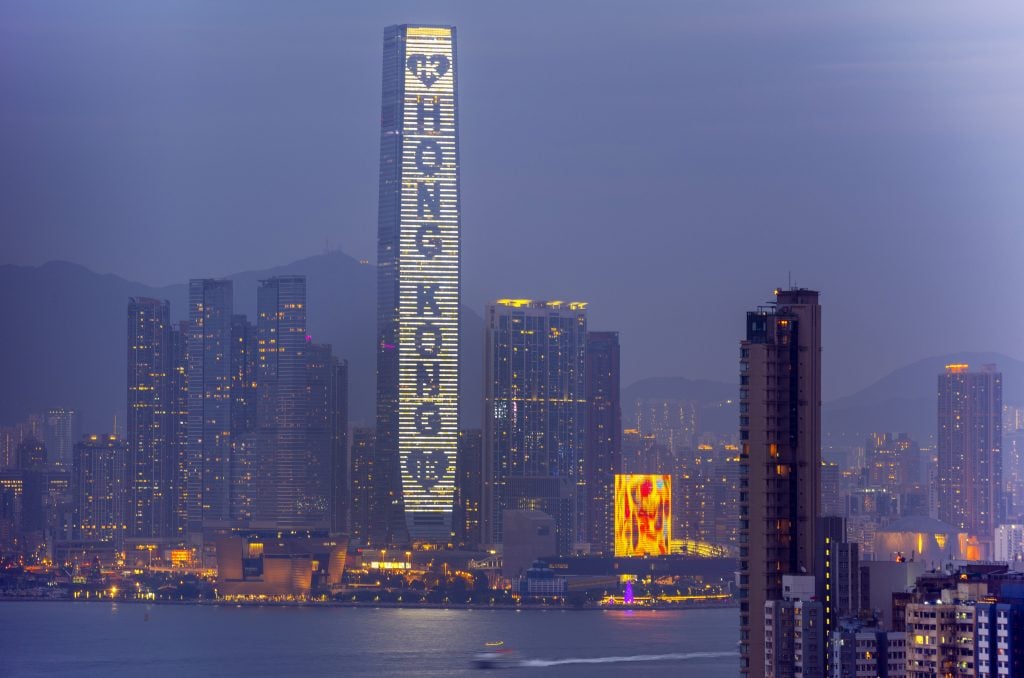
The international art crowd has high expectations, while local players are hoping for the best.

The glamorous parties and private dinners are back. The international crowd of collectors, museum directors, and industry players have returned. The uplifting vibe and excitement surrounding this week’s Art Basel Hong Kong are more than gestures to celebrate the city’s reemergence onto the world stage. They also signify the global art world’s vote of confidence in the city as a key hub and market in Asia.
Indeed, the countless number of art events happening this week—collectively known as the Hong Kong Art Week—carry much heavier meaning. It aligns with the local government-led “Hello Hong Kong,” a major campaign to promote the city to the world after draconian Covid restrictions were lifted, and society’s order was “restored” as political unrest was curbed, dissidents kept behind bars, and critical voices largely silenced (or departed).
Some critics have questioned whether it would be morally right for the international art world, particularly that of the west, to continue to deal with institutions and industry players in countries under authoritarian rule, including Saudi Arabia and Hong Kong after Beijing’s imposition of the sweeping national security law in 2020. But the reality is that life still has to go on. Business still needs to be done; artists and industry professionals are persevering to make the most out of what’s left of their beloved “Home Kong,” an affectionate nickname for the city.
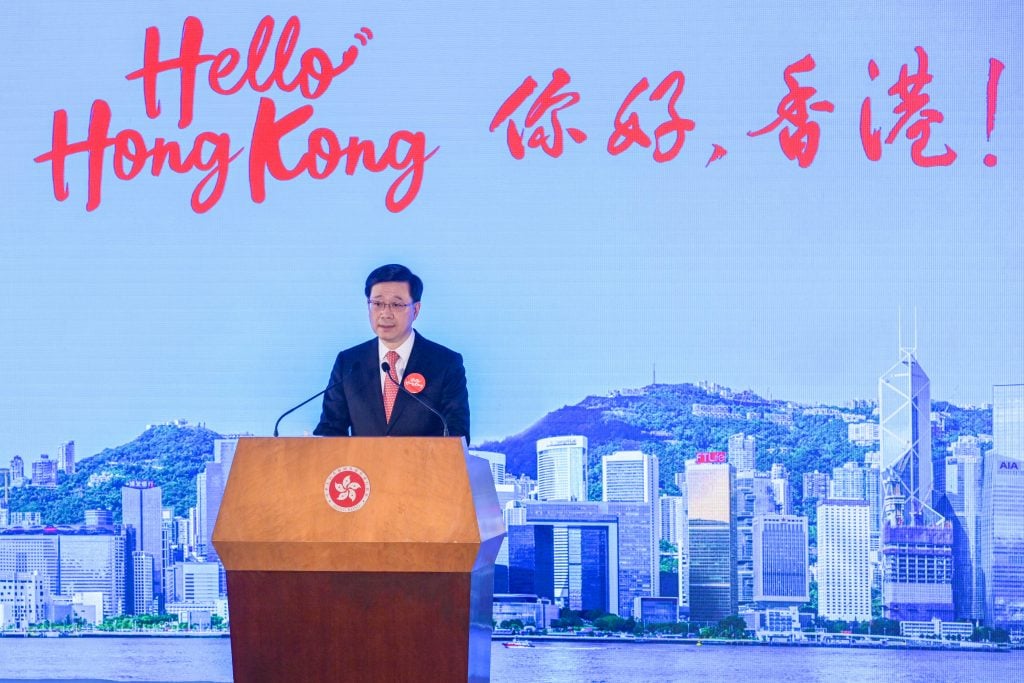
Hong Kong Chief Executive John Lee Ka-chiu launching the “Hello Hong Kong” campaign on February 2 in Hong Kong, China. Photo: Chen Yongnuo/China News Service/VCG via Getty Images.
What’s more, despite the fact that neighboring cities Seoul, Singapore, and even Tokyo have been stepping up their efforts in cultivating their respective art markets when Hong Kong was almost sealed off from the world during Covid for nearly three years, the international art world has yet to find another place that can replace Hong Kong’s role as of now.
“Hong Kong’s status as a trading hub to the international art world is still irreplaceable, despite everything,” noted Gladys Lin, an independent art advisor based between Taipei and New York.
Hong Kong Art Week’s event schedule and guest lists speak for themselves. The past few days already saw receptions, dinners, and openings staged by M+, Design Trust, Art Basel, and Phillips, which, this week, inaugurates its new Asia headquarters in West Kowloon Cultural District, becoming a neighbor of M+.
Property tycoon and mega collector Adrian Cheng hosted a star-studded dinner and party on Sunday to unveil graffiti and street art exhibition “City As Studio” at his property K11 Musea, attended by a long list of international guests including H.E. Sheikha Al-Mayassa bint Hamad bin Khalifa Al-Thani, chairperson of Qatar Museums; Neue Nationalgalerie’s director Klaus Biesenbach; Maja Hoffmann, founder and president of Luma Foundation in Zurich; Alexandra Munroe, curatorial affairs director at Guggenheim Abu Dhabi; Musée National Picasso’s president Cécile Debray; Pinault Collection’s senior curator Caroline Bourgeois, as well as artists Beeple, Aiko, and Katharina Grosse. Collectors Haryanto Adikoesoemo and Neil Shen were also among the guests.
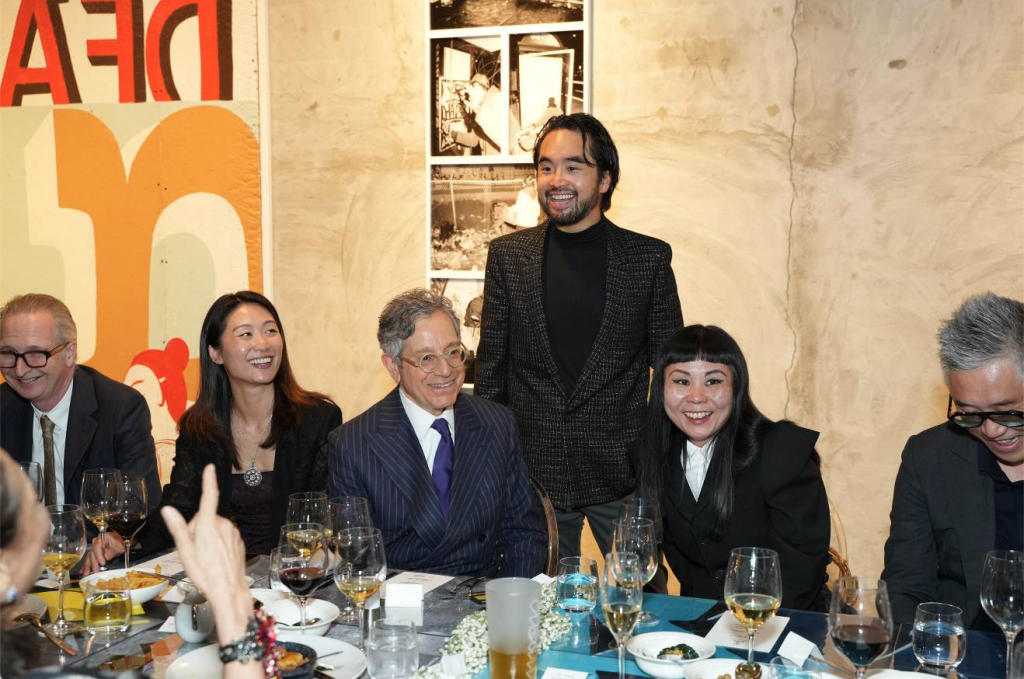
From left: Brett Gorvy, co-founder of Lévy Gorvy, collector Jasmine Li, curator Jeffrey Deitch, Adrian Cheng (standing), artist Aiko, and architect Mark Lee at the opening dinner for “City As Studio” on March 19, 2023, in Hong Kong. Photo courtesy K11 Musea.
In addition to numerous gallery openings, more big parties are expected throughout the week, including at the Art Gallery of New South Wales on Thursday and Los Angeles County Museum of Art (LACMA) on Friday.
Art Basel, which opens to VIP preview on Tuesday at Wan Chai’s Convention and Exhibition Centre, will see 177 galleries from more than 30 countries and territories exhibiting. That figure is still 27 percent down compared to 2019’s 242 galleries, but already a significant increase in the number of exhibitors compared to 137 in 2022 and 104 in 2021, due to long Covid quarantines for inbound travelers. The satellite fair Art Central, also taking place in the same complex, will have 70 exhibitors, of which 39 come from overseas.
In addition to Phillips, Sotheby’s and Christie’s are also pressing ahead with big plans in Hong Kong. Both Phillips and Sotheby’s declined to comment on Artnet News’s inquires about the impact of the local and geopolitical situation, but their numbers speak louder than words. Sotheby’s, which is celebrating its 50th anniversary in Asia this year, achieved $1.1 billion sales in Asia in 2022, in line with the all-time-high record achieved in 2021, and its number of Asian clients aged below 20 has tripled in 2022. The house is expecting new headquarters in Shanghai and Hong Kong in 2023 and 2024 respectively.
Christie’s, on the other hand, declined to comment on political matters, but noted that its art business in Hong Kong has not been impacted. The house’s 20th/21st-century art auctions in Asia, which took place in Hong Kong and Shanghai, achieved HK$3.4 billion ($434 million) in 2022, the second highest in this category in the region, after 2021’s record total HK$4.3 billion ($548 million). Contribution to global sales from buyers in Asia-Pacific region in 2022 reached $1.8 billion, the highest amount since 2015.
“Hong Kong as a key art hub in APAC is here to stay, and Hong Kong has competitive advantages that took decades to build and to be matched,” Francis Belin, president of Christie’s Asia Pacific, told Artnet News, highlighting free flow of capital, tax-free port, logistics, and experienced talents being the city’s key strengths.
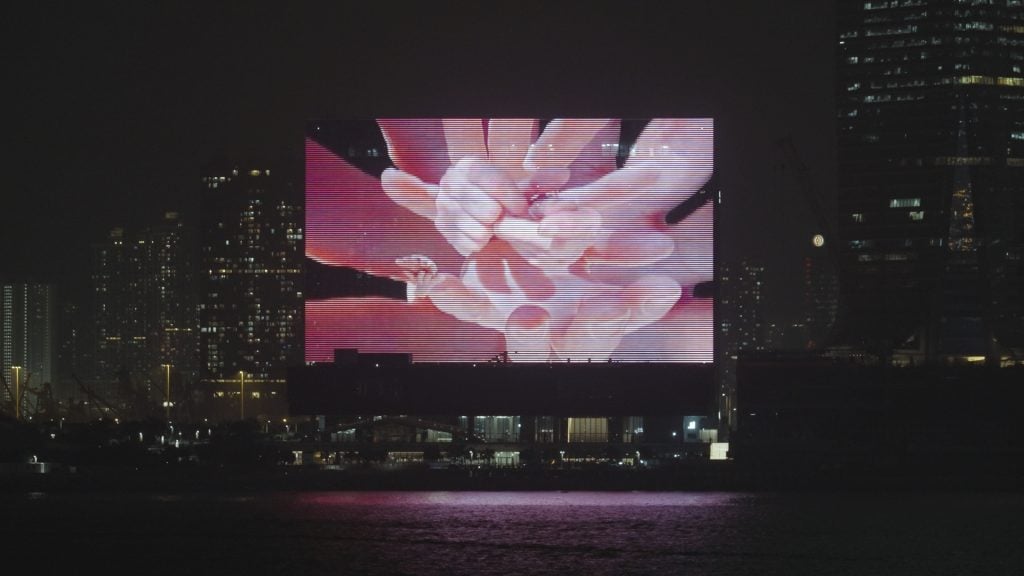
Pipilotti Rist, Hand Me Your Trust (2023) on the facade of M+, supported by Art Basel and UBS. Photo: Moving Image Studio, courtesy of Pipilotti Rist and M+, Hong Kong.
Contrary to the grim picture of Hong Kong often depicted in some international media outlets, which have covered issues from the curb of freedoms to the economic downturn and population exodus, the local art market has been performing quite well, particularly since the pandemic. “You are likely to make a profit if you sell Hong Kong art,” one Hong Kong-based dealer told Artnet News.
Hong Kong has been experiencing a gallery boom. Data from the Hong Kong Art Gallery Association shows that the number of member galleries went from 49 in January 2021 to 62 in March 2023, a nearly 27 percent jump. The actual number of galleries, including those that didn’t sign up for the association’s membership, is much higher. “This shows the confidence that the art industry has in Hong Kong and its environment as the pre-eminent place in Asia,” noted the association’s co-president Fabio Rossi of gallery Rossi & Rossi.
One of main factors for this unexpected gallery boom, according to local industry insiders, is the rise of a new generation of wealthy collectors who are hungry for art produced by Hong Kong artists. And there are no lack of celebrities, such as former Miss Hong Kong Louisa Mak, whose successful bid for an artwork at last year’s Para Site charity dinner in a revealing outfit made local entertainment news headlines, rare coverage of an art event in mainstream media.

Installation view of Michele Chu’s seeping (2023) at “you, trickling,” PHD Group, 2023. Photo: Felix SC Wong, courtesy the artist and PHD Group, Hong Kong.
This transformation has opened up new possibilities. Collector Matt Chung took his passion one step further. He opened Gallery Ascend in 2021 and last year co-founded Haus of Contemporary, a six-story complex of art gallery and event spaces, with his partner Samson Ko. “I wish to bridge the gap between affordable art and academic art,” Chung told Artnet News.
Willem Molesworth, formerly a director of de Sarthe, and Ysabelle Cheung, a former editor at ArtAsiaPacific, co-founded PHD Group last year, transforming Cheung’s family property from an idled private clubhouse into an edgy gallery space that attempts to push boundaries. Throughout the art week, PHD Group will stay open 24/7 to welcome visitors to its new exhibition “You, Trickling,” the solo debut of 1994-born Hong Kong-based artist Michele Chu. The conceptual, immersive show deals with loss, trauma, and memory, an artistic response to the “tremendous loss and trauma” experienced in the city and elsewhere in recent years,” noted Molesworth.
“Hong Kong’s art scene has continued to flourish. The city has been through the ringer, but I think that has kickstarted a process where people are reevaluating their priorities,” Molesworth told Artnet News. “There has been a seismic shift toward embracing more conceptual art—across institutions, galleries, and the collecting class.”
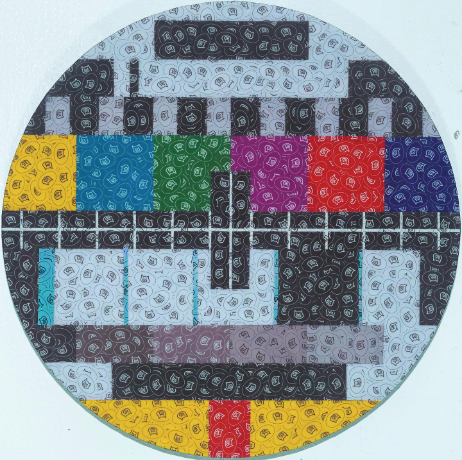
Damon Tong, OING (circle) (2023). Photo courtesy of the artist.
Indeed, the past few years have been fruitful to some artists who remain in Hong Kong. Locally successful names are beginning to get international market recognition. Stephen Wong Chun Hei held his first overseas solo at Unit London last November. Mak2 (Mak Ying Tung 2) will be opening her overseas solo debut at Peres Projects in Berlin this Friday, after a recent solo show in Taipei. Chan Wai Lap, on the other hand, is gaining a great deal of exposure after his art featured in a local pop concert.
“Many artists can make a living by selling their works, which was impossible in the past,” artist Damon Tong told Artnet News. He will be getting his first solo booth presentation with Art Projects Gallery at Art Central. “This week is an important opportunity for us to be seen by the international community.”
While some artists who deal with political subjects, such as artist Kacey Wong, have fled the city over the past two years, and censorship, both institutionalized and self-imposed, is more prominent than ever, many artists have chosen to remain. In addition to navigating an invisible red line that’s constantly shifting, they have more to figure out.
“Politics and artistic freedoms, the issues that are constantly played out in the narrative of the western media, aren’t even what we have to deal with on a day-to-day basis,” one artist told Artnet News on the condition on anonymity.
“We are facing survival issues: nurturing our relationships with galleries, finding collectors to acquire our works, and making a living to pay our bills. Many of us are navigating the dynamics of these new affluent collectors. Their wealth has supported the local art scene the past two years, but will this party be over one day? The uncertainties worry us,” they added.
“Are we worried about the political implications? Of course we are. But just like farmers who live close to volcanoes, the crops grow better on the fertile volcanic soil. And it is our choice to stay as we continue to create.”